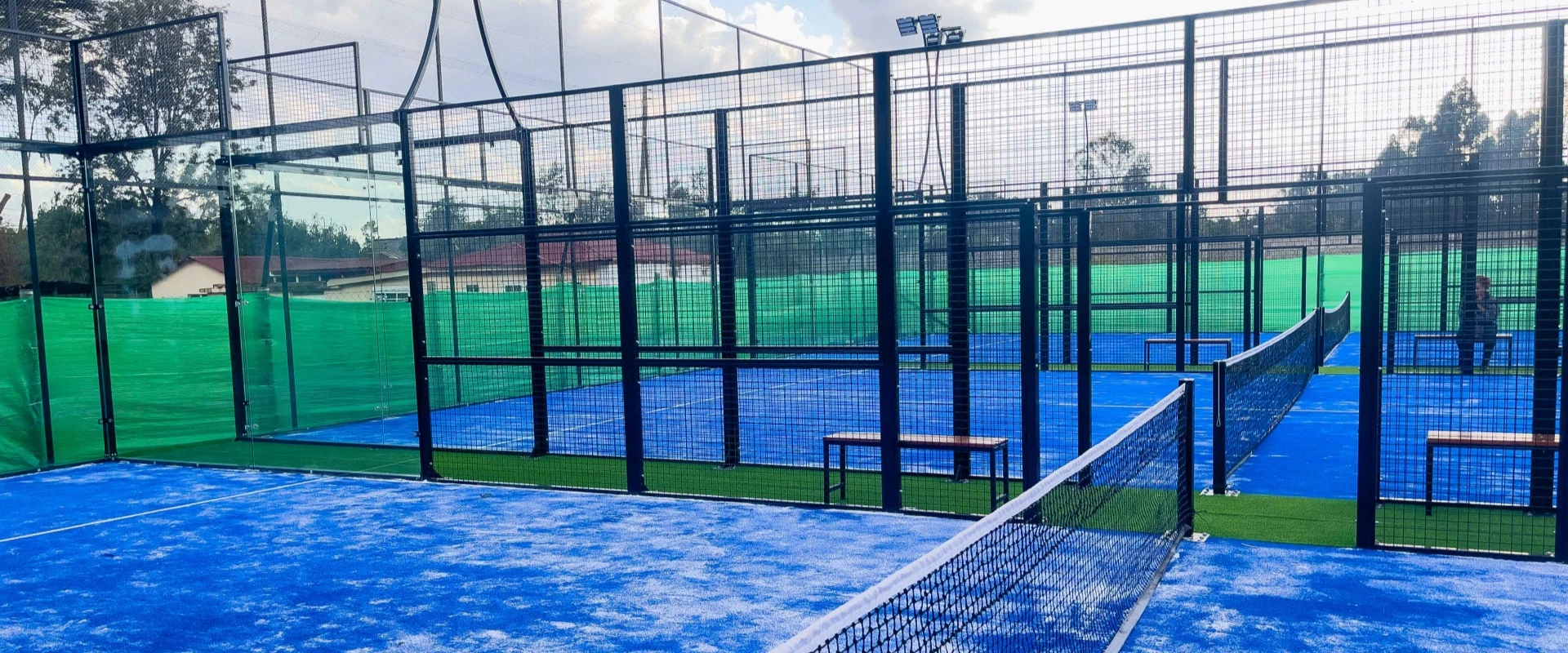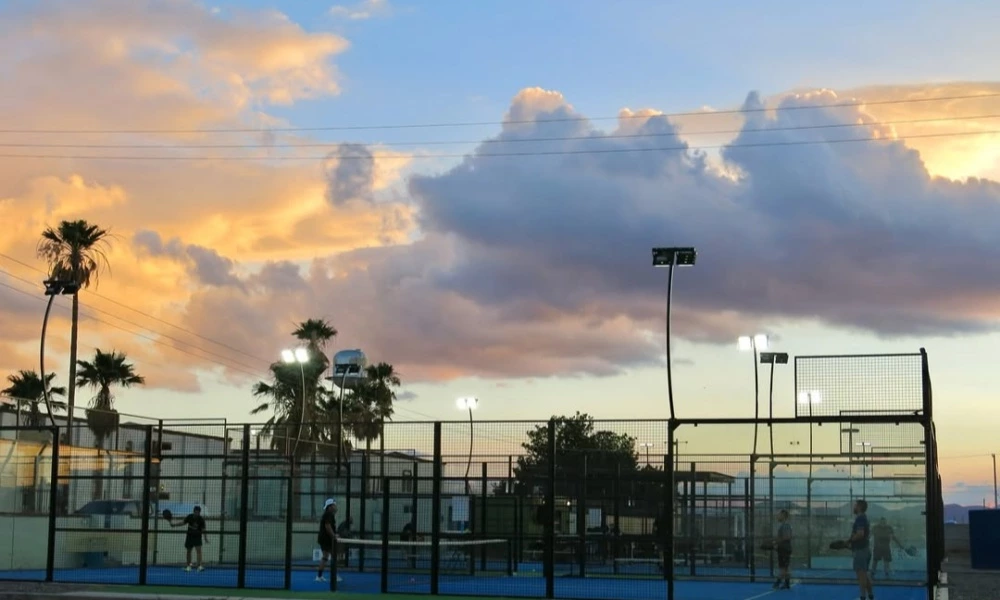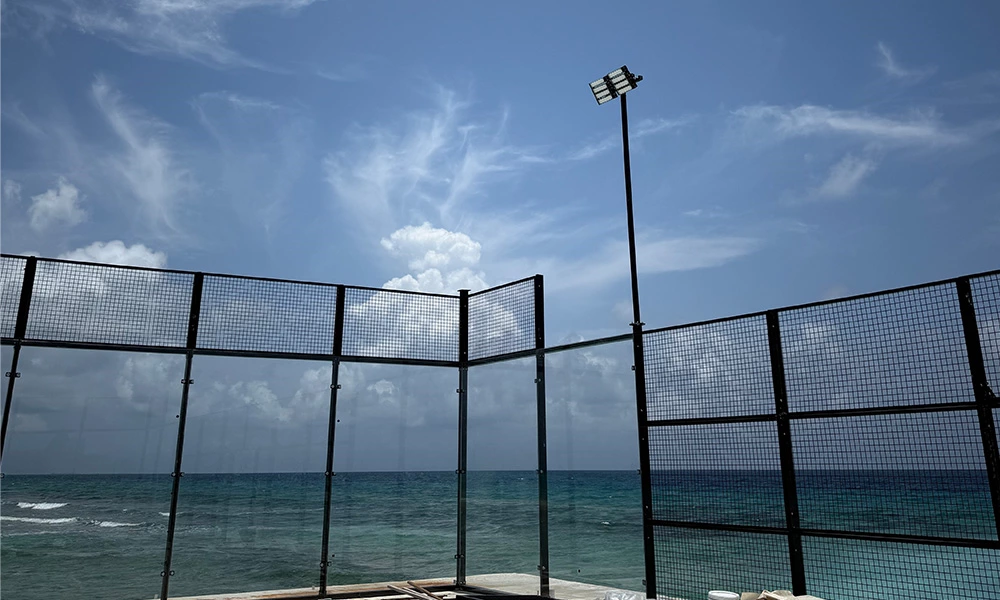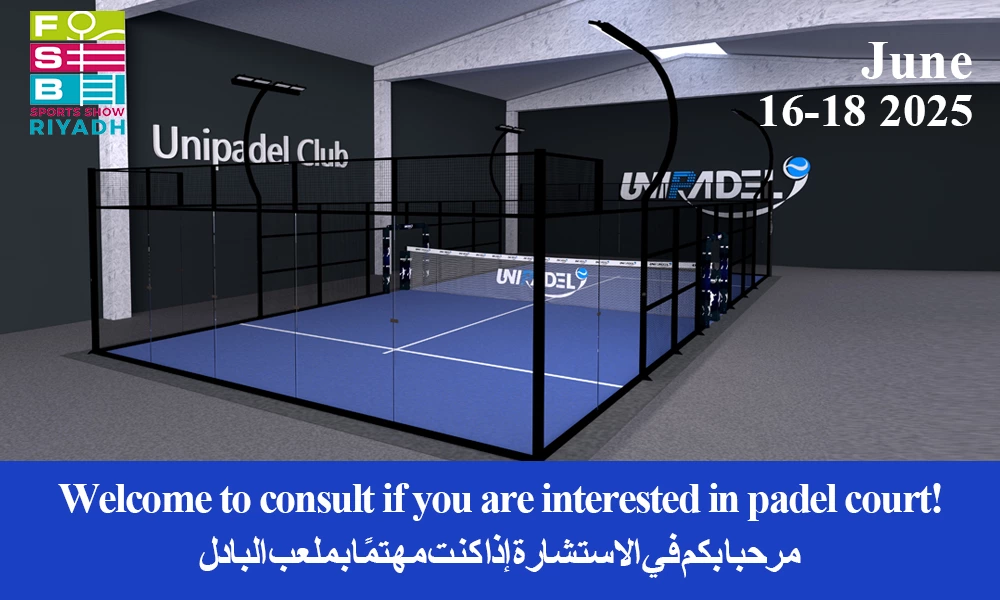Construccion pista de padel: instalacion y precio
Si planea construir una o más pistas de pádel, o incluso un club de pádel completo, es fundamental evaluar cuidadosamente los factores relevantes antes de iniciar el proyecto. Este artículo le proporcionará un desglose paso a paso de los puntos clave a considerar al implementar este plan.
Exploraremos los costos de construir una pista de pádel, ayudándole a comprender los elementos clave a considerar al elaborar un presupuesto de proyecto. Haremos hincapié en la importancia de la construcción de pistas de pádel y detallaremos los requisitos de cimentación, las etapas de construcción y los precios, junto con los costos de construcción de pistas cubiertas y al aire libre. También nos centraremos en un aspecto a menudo pasado por alto, pero igualmente importante: elegir el mejor software de gestión de reservas para su pista de pádel.
¿Cuáles son los tres pasos importantes antes de construir una pista de pádel?
Antes de completar la construcción de una pista de pádel, se requieren una serie de pasos clave para garantizar su correcto funcionamiento.
- Arrendamiento del Terreno: Se debe firmar un contrato de arrendamiento formal con el propietario o el parque, que defina claramente el plazo del arrendamiento, la renta y los derechos de uso para garantizar la estabilidad operativa futura.
- Aprobación del Terreno: Implica presentar la documentación pertinente al gobierno local o al departamento de planificación para garantizar que el terreno cumpla con las normas de construcción y los requisitos de seguridad, y obtener el permiso legal para su uso.
- Diseño de la Disposición de la Cancha: Con base en la superficie del terreno, las ubicaciones de entrada y salida, y la disposición de las áreas de espectadores y de descanso, la orientación y el espaciamiento de cada cancha se planifican estratégicamente para garantizar una buena iluminación, ventilación y un espacio seguro para los jugadores durante el juego, a la vez que facilitan la operación y el mantenimiento posteriores.
Mediante estos tres pasos, una cancha puede pasar de la fase de construcción a la de operación, entrando realmente en uso y brindando a los jugadores una experiencia deportiva positiva.
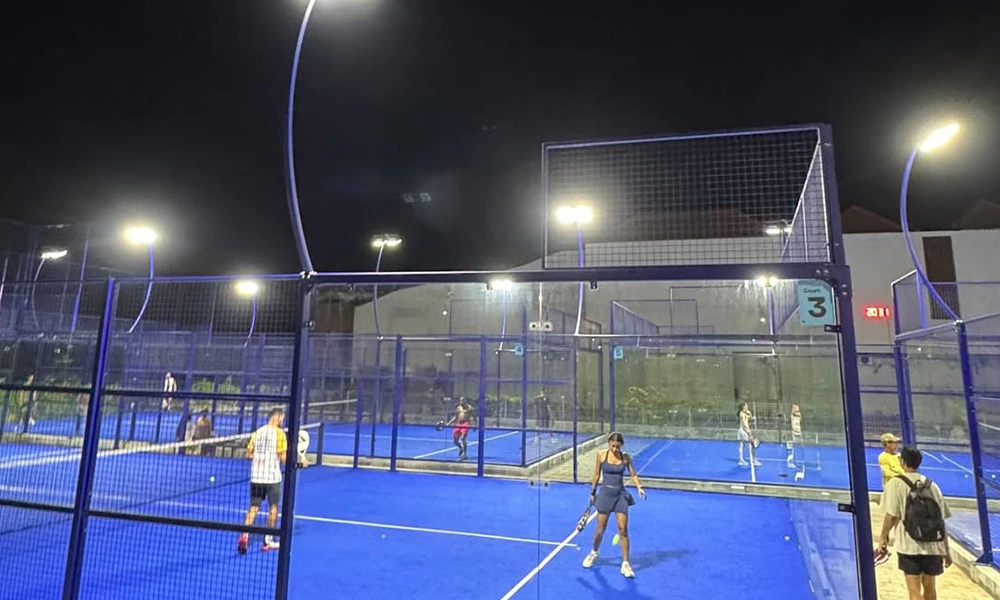
¿Cuánto espacio se necesita para construir una pista de pádel?
Al construir una pista de pádel, la planificación del espacio es crucial. Las dimensiones estándar de una pista de pádel son 20 metros de largo y 10 metros de ancho, mientras que las dimensiones de una pista individual son 20 metros de largo y 6 metros de ancho.
Para garantizar una buena experiencia de juego, el espacio mínimo requerido para una pista de dobles es de 11 metros por 21 metros, más 0,5 metros de espacio de seguridad adicional a cada lado, con una superficie mínima de aproximadamente 231 metros cuadrados. El espacio requerido para una pista individual es de 11 metros por 7 metros, más una zona de seguridad de 0,5 metros.
Aunque estos son los requisitos mínimos, recomendamos dejar más espacio alrededor de la pista para mejorar la experiencia de juego. Especialmente en espacios al aire libre, el impacto de la luz solar y el viento es crucial, y una distribución y dirección adecuadas mejorarán significativamente la calidad del juego. Como proveedor de UNIPADEL, ponemos énfasis en brindar a los clientes productos de alta calidad y asesoramiento profesional en diseño para garantizar que cada jugador pueda disfrutar de la mejor experiencia de pádel.
¿Cómo elegir y construir la cimentación para una pista de pádel?
Al construir una pista de pádel, la nivelación de la cimentación es crucial, especialmente para garantizar que el terreno esté completamente nivelado, sin baches ni desniveles. Esto afecta a tres aspectos clave:
La estabilidad de la estructura y la instalación del acristalamiento;
Los problemas de drenaje con la lluvia y la formación de encharcamientos;
La calidad del juego, especialmente el bote de la pelota.
¿Cuáles son cuatro soluciones comunes de cimentación?
- Losa de hormigón semipulido: Al utilizar una losa de hormigón semipulido, es necesario colocar el encofrado perimetral, aplicar malla o fibra de 6 mm y hormigón (como HM-25/20MM) para construir la losa. La losa debe tener al menos 21 metros de largo y 11 metros de ancho, con un espesor de 12 a 15 cm. Debe mantenerse plana y garantizar que la estructura de la pista de pádel pueda colocarse y fijarse. Si se requiere una pendiente de drenaje, esta suele ser inferior al 0,5 % en un lado. El tratamiento final de la superficie suele ser un pulido con helicóptero para evitar resbalones sobre la superficie del césped. Si la pista se encuentra en una zona exterior sin pavimentar, UNIPADEL recomienda utilizar losas de hormigón semipulido como cimentación. Este material generalmente tiene una pendiente transversal del 0,5 %, lo que facilita el drenaje y suele ser la solución preferida por su durabilidad, rentabilidad y rapidez de construcción.
- Losa de hormigón poroso: Si la pista está ubicada en un terreno completamente nivelado o en un lugar donde el campo pueda recoger eficazmente el agua de lluvia, UNIPADEL recomienda el uso de losas de hormigón poroso. Este diseño permite recoger eficazmente el agua de lluvia drenándola a través de la superficie porosa y manteniendo toda la superficie plana y elevada.
- Cimentación de hormigón poroso: Para pistas de pádel con cimentación de hormigón poroso, la franja perimetral debe tener al menos 30 x 30 cm de ancho (se recomiendan 40 x 40 cm) y estar reforzada con hormigón adecuado para la cimentación (por ejemplo, HM-25/20MM) y las barras de acero correspondientes. El espesor de la capa de hormigón en la zona de juego de la pista debe ser de 15 a 18 cm, con las barras de acero correspondientes para garantizar la estabilidad estructural.
- Asfalto: Es una opción común con un coste inicial relativamente bajo, lo que lo convierte en una opción popular para pistas al aire libre. Proporciona una cimentación estable, pero en condiciones climáticas extremas, el asfalto puede agrietarse o desplazarse, lo que requiere un mantenimiento regular.
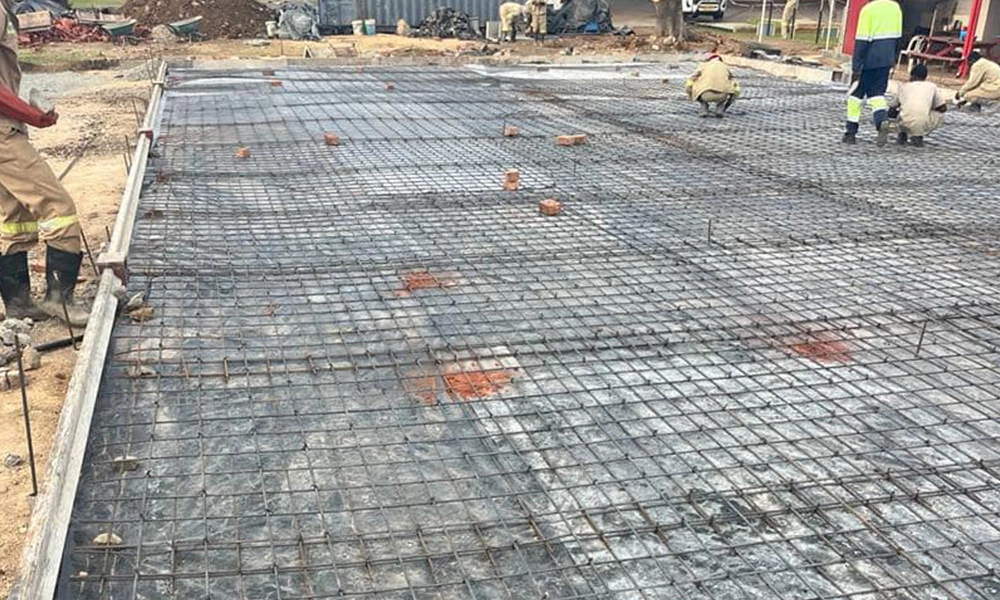
Cómo construir la cimentación?
Para la construcción de la cimentación, se suele seguir el siguiente procedimiento:
- Compactación de la base: Primero, se compacta la base, ya sea con grava natural o grava Z2 seleccionada, hasta alcanzar una compactación Proctor modificada del 96%.
- Capa de grava artificial: Se coloca una capa de grava artificial para formar una pendiente de drenaje.
- Losa de hormigón HM-25: Se construye una losa de hormigón con una pendiente adecuada para garantizar un buen drenaje.
- Tubos de drenaje: Se utilizan tubos de drenaje para guiar el flujo de agua. Si se utilizan losas a dos aguas, la pendiente de drenaje suele ser hacia los lados de la cancha para asegurar un flujo de agua fluido.
- Capa de drenaje: Se coloca grava drenante de 8 a 20 cm de espesor debajo de la losa de hormigón para facilitar el flujo de agua.
- Tratamiento de la superficie: Finalmente, se coloca un pavimento poroso de 12 a 15 cm de espesor sobre la superficie, y los bordes se construyen con grava ligera seleccionada y mortero de cemento para garantizar la planitud y la pendiente necesaria para un drenaje eficaz.
Cómo se conectan las luminarias a la cimentación?
Los circuitos de iluminación pueden instalarse mediante conductos empotrados en la losa o en ranuras perimetrales. Estas ranuras guían los circuitos de iluminación hacia respiraderos o cajas de protección, los cuales deben instalarse cerca de las farolas. Una vez excavada la zanja, debe rellenarse o cubrirse adecuadamente para evitar riesgos de seguridad.
UNIPADEL recomienda: al elegir un material de base, es necesario considerar el presupuesto del proyecto, la frecuencia de uso prevista y las condiciones climáticas. Si bien el hormigón implica una mayor inversión inicial, su durabilidad a largo plazo y su bajo mantenimiento pueden ayudar a los operadores de las instalaciones a reducir eficazmente los costos de reparación futuros. Por lo tanto, a largo plazo, el hormigón es una opción ideal para quienes desean minimizar los gastos futuros.
Cómo construir una pista de pádel de estándar internacional? (Cada parte de la pista)
Proceso de instalación de una pista de pádel
El proceso de instalación de una pista de pádel requiere procedimientos precisos y ordenados. Primero, se fijan los pilares para garantizar la estabilidad estructural general. A continuación, se instala la red para proporcionar el cerramiento básico de la pista. El vidrio templado se instala cuidadosamente para garantizar la seguridad y la transparencia visual. A continuación, se instalan los brazos de iluminación para proporcionar iluminación nocturna. Finalmente, se coloca césped artificial para garantizar una superficie lisa, atractiva y con buena elasticidad. Finalmente, si es necesario, se instala la cubierta de pádel para mejorar la protección contra el viento y la lluvia, creando una pista profesional para todo tipo de clima.
Las 6 partes de la pista de pádel presentan los detalles de instalación:
- Valla: La instalación de la valla es crucial. La altura estándar es de 4 metros, creando un espacio cerrado alrededor de la pista para garantizar el rebote de la pelota y la fluidez del juego. Marcos presoldados (=1 pieza) para máxima estabilidad en lugar de una construcción de varias piezas, 2 barras horizontales en el lado de la malla para una estabilidad y flexibilidad óptimas. Tubos de acero de 80 x 40 mm en el resto de la estructura (en lugar de 40 x 40 mm). El material de la valla suele ser polietileno de alta resistencia o malla tejida de nailon, con buena resistencia a la intemperie y a los impactos. Durante la instalación, es necesario asegurar que la tensión del alambre de la red sea uniforme para evitar deformaciones causadas por el viento o los impactos.
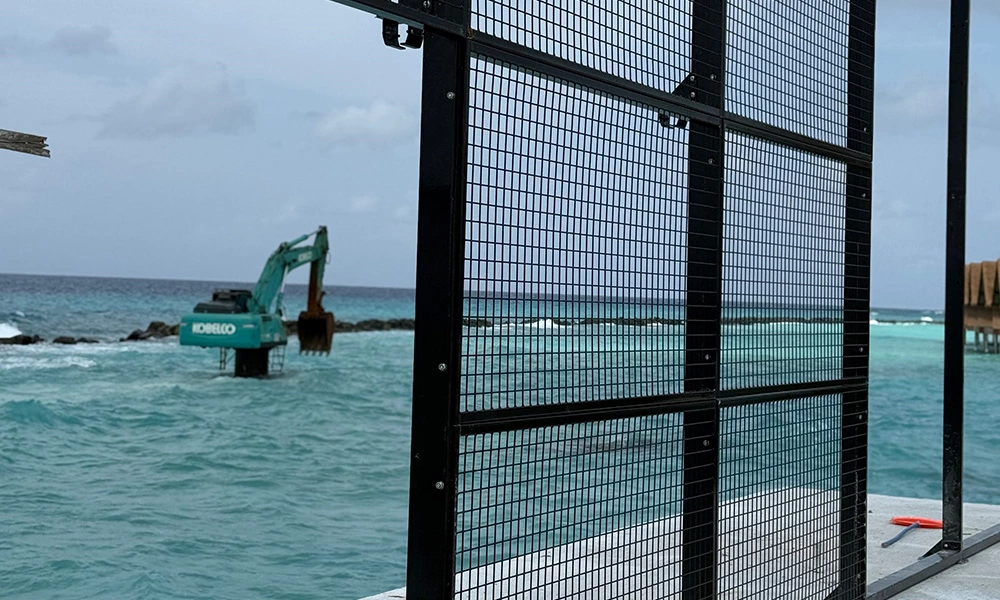
- Pilares: La instalación de los pilares debe ser firme y estable. Acero galvanizado en caliente y protección anticorrosiva extralarga opcional (para zonas con alta carga de corrosión), recubiertos con pintura en polvo según procedimientos estrictos. Cuatro puntos de fijación de tubos de refuerzo y seis tornillos de expansión por columna vertical sujetan la estructura al suelo. Los pilares suelen estar hechos de tubos de acero galvanizado en caliente de 10 cm de diámetro y enterrados a una profundidad mínima de 1 metro para garantizar su estabilidad en competiciones de alta intensidad. Tubos de refuerzo de 80 x 80 mm en las columnas verticales. La posición de los pilares debe adaptarse al tamaño del recinto para garantizar una conexión estrecha con la valla y evitar que el movimiento afecte al juego.
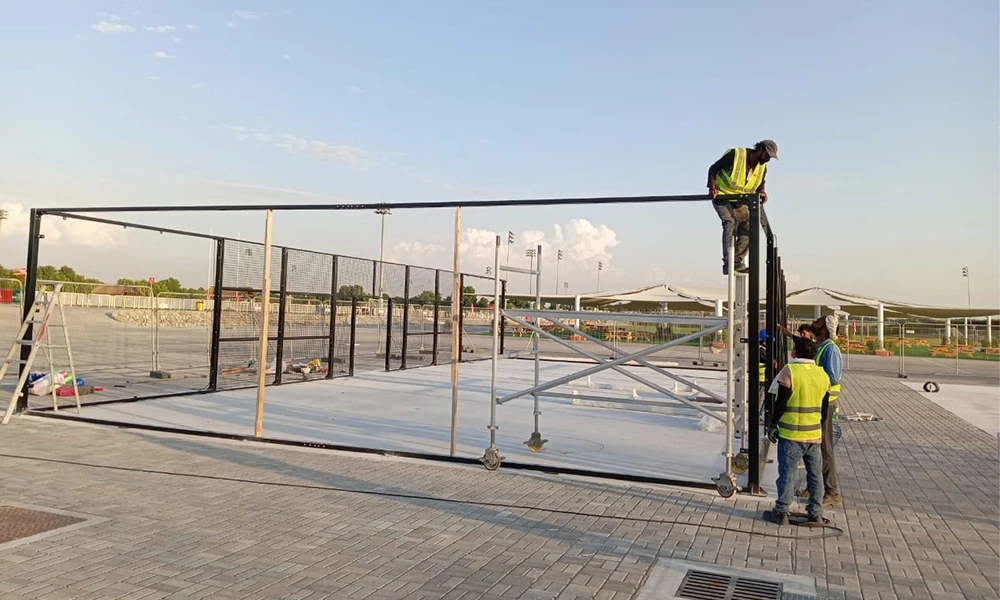
- Vidrio templado: La instalación de vidrio es clave para mejorar el efecto visual del recinto y la experiencia de juego. Un tubo de acero de 80 x 40 mm soporta el vidrio en los 4 lados para una máxima estabilidad del vidrio. La altura del vidrio de una pista de pádel estándar es de 3 metros, y generalmente se usa vidrio templado con un espesor de 12 mm para garantizar la seguridad. La instalación del vidrio requiere el uso de accesorios profesionales para evitar roturas o desplazamientos durante una competencia intensa. Al mismo tiempo, la superficie del vidrio debe mantenerse limpia para garantizar que los espectadores y atletas puedan observar claramente el juego. Nota al cargar y descargar el vidrio: Asegúrese de usar tiras de madera como amortiguadores para que no sea fácil golpear objetos duros y romperlos. Al instalar el vidrio en el marco, ajuste la posición y luego levántelo sobre el marco.
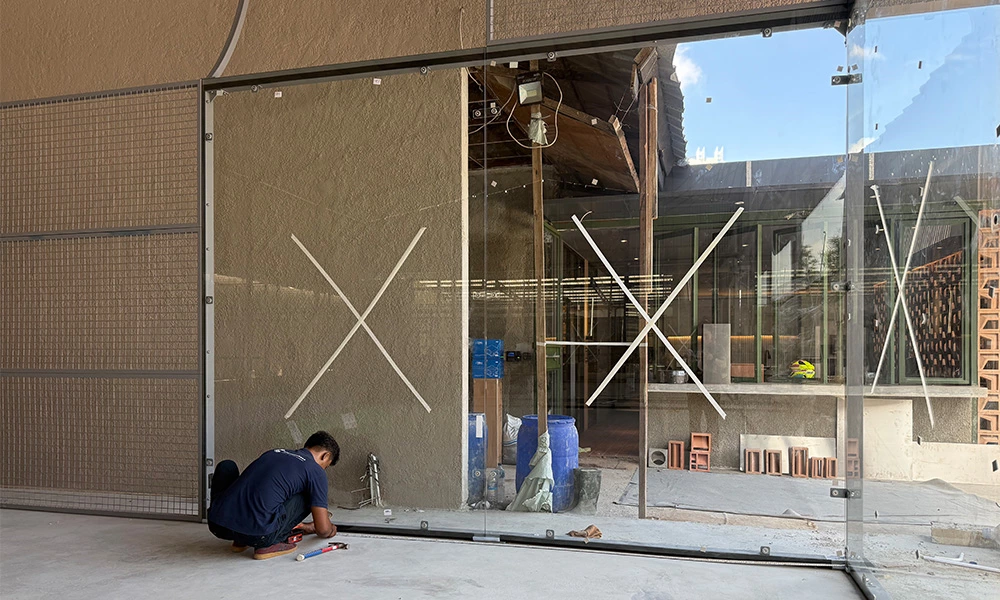
- Iluminación: Al construir la pista de pádel, UNIPADEL prestó especial atención al diseño de la iluminación y el césped para garantizar la mejor experiencia a los atletas. En primer lugar, el sistema de iluminación utiliza iluminación LED de alta eficiencia para proporcionar una iluminación uniforme, reducir las sombras y el deslumbramiento, y ayudar a los atletas a mantener la concentración durante el juego. La intensidad de la iluminación se puede ajustar para adaptarse a las necesidades de diferentes horarios y actividades, garantizando su uso en cualquier condición climática.
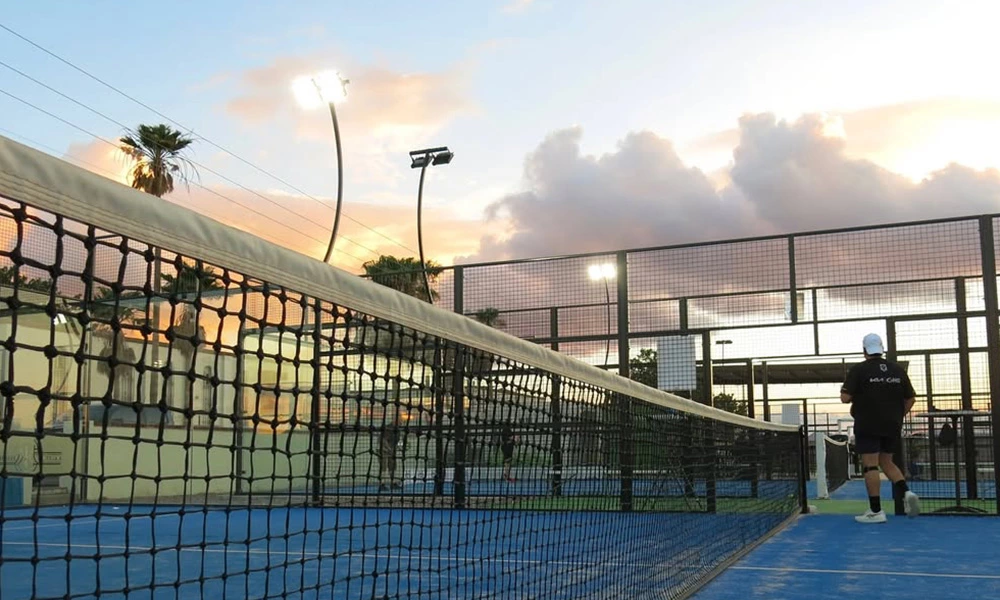
- Césped artificial de pádel: La elección del césped artificial es crucial. UNIPADEL utiliza césped artificial KDK mejorado. Este césped de alta calidad ofrece una excelente resistencia al desgaste y elasticidad, lo que reduce eficazmente las lesiones deportivas. El color y la textura del césped están cuidadosamente diseñados, lo que no solo proporciona un excelente efecto visual, sino que también mejora el agarre y la calidad general del juego. El sistema de mantenimiento del césped simplifica la limpieza diaria, garantizando que la pista esté en las mejores condiciones para los atletas. Este diseño integral hace que la pista de pádel de UNIPADEL sea atractiva y práctica.
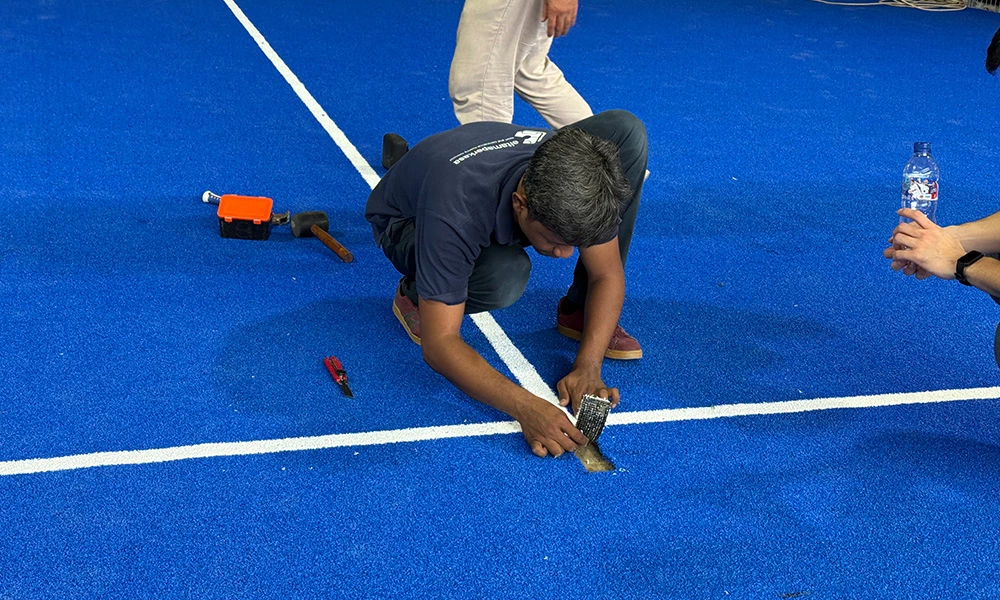
- Cubiertas/Techos de Pistas de Pádel: El proceso de construcción de las pistas de pádel cubiertas es similar al de las panorámicas, pero incluye la instalación de la estructura y el sistema de iluminación. Tras preparar el terreno, se instalan las columnas de las esquinas y centrales mediante un sistema modular de conexión atornillada. Estas estructuras proporcionan estabilidad y soporte para la instalación del techo. Se instalan paneles de vidrio templado de 12 mm de alta calidad en la pared trasera y los laterales para aumentar la transparencia y durabilidad. Se instalan 4 postes de luz en las cuatro esquinas de la pista, con 2 reflectores LED de alta luminosidad en cada poste. Este diseño garantiza una excelente iluminación nocturna y es ideal para cualquier clima. El techo, fabricado con materiales ligeros y duraderos, se fija a las columnas de las esquinas y centrales para proporcionar sombra y protección contra la lluvia. Toda la estructura del techo se instala siguiendo estrictamente las especificaciones internacionales para garantizar su seguridad y practicidad.
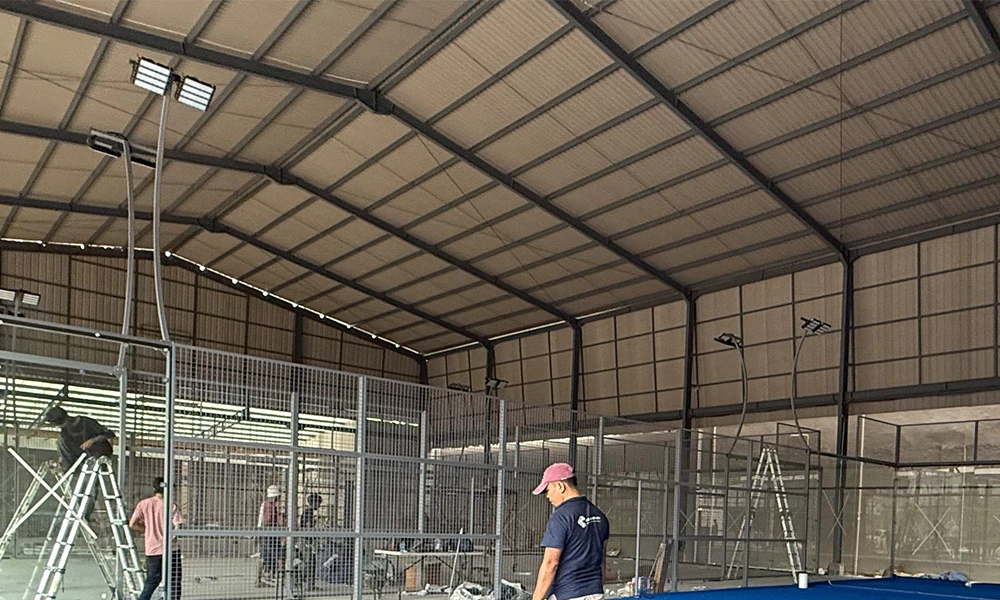
Precio básico de pista de pádel
UNIPADEL ofrece una variedad de soluciones para pistas de pádel, con un precio básico de fábrica de entre 9.500 y 9.800 $, lo que representa una excelente relación calidad-precio. Para los clientes que necesitan cobertura, la compañía ha lanzado dos sistemas de techo integrado: la pista panorámica con techo integrado, con un precio de entre 18.000 y 19.500 $, que ofrece protección integral y es ideal para quienes buscan un mantenimiento simplificado; y la pista panorámica con techo dividido, con un precio de entre 20.000 y 21.000 $. Aunque el precio es ligeramente superior, se adapta a diversos entornos y requisitos de uso gracias a su diseño flexible, ofreciendo a los clientes mayor libertad y comodidad.
Precio de construcción de cimientos de pista de pádel
UNIPADEL le recuerda que debe comprender los pasos clave para la construcción de una pista de pádel. Tras el estudio inicial del terreno, el nuevo constructor debe excavar y nivelar el terreno. La construcción de los cimientos de la pista de pádel es un paso crucial. Recomendamos colocar una capa sólida de hormigón sobre el suelo, seguida de una capa de asfalto para garantizar la estabilidad y durabilidad de la pista. Dependiendo del tamaño y la ubicación de la pista, el costo de la construcción de los cimientos suele oscilar entre US$3.000 y US$10.000.
Diferencia entre los precios de las pistas de pádel interiores y exteriores
La diferencia de precio entre las pistas de pádel interiores y exteriores se debe principalmente a los costos de alquiler y mantenimiento del recinto. Las pistas interiores suelen requerir tarifas de alquiler más altas, así como inversión en estructuras, techos, iluminación y sistemas de ventilación, lo que resulta en costos generales aproximadamente entre un 20% y un 40% más altos que las pistas exteriores. Sin embargo, en regiones con alta humedad como Indonesia, Malasia y Tailandia, las pistas interiores protegen eficazmente las estructuras de acero y el vidrio de la corrosión, prolongando su vida útil. En países con inviernos fríos como Europa, las pistas interiores están equipadas con sistemas de calefacción para garantizar su funcionamiento durante todo el año. Si bien la inversión inicial es mayor, las pistas interiores ofrecen una experiencia de usuario más estable y una mayor rentabilidad.
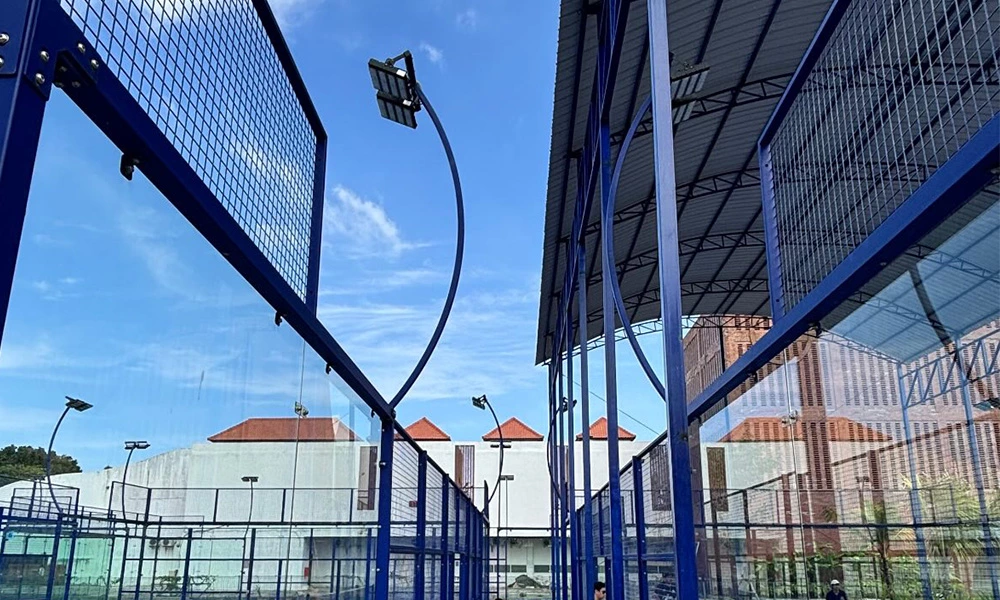
Cómo puede el Grupo UNIPADEL ayudarte a construir tu pista de pádel ideal?
Para cualquier operador de instalaciones deportivas que desee mantenerse a la vanguardia, construir una pista de pádel de alta calidad es una inversión visionaria. Con una amplia experiencia y una excelente capacidad de fabricación, el Grupo UNIPADEL se compromete a ofrecer servicios integrales, desde el diseño hasta la implementación, a clientes de todo el mundo.
1. Soluciones de diseño a medida
Cada instalación tiene sus propias particularidades. Ofrecemos servicios de diseño personalizados según tus necesidades específicas, ya sea una pista de pádel individual o un espacio deportivo compuesto por gradas de baloncesto integradas y áreas de uso multifuncional. Nuestro diseño no solo se centra en el uso eficiente del espacio, sino que también tiene en cuenta la experiencia deportiva y el impacto estético.
2. Selección de materiales de alta calidad para garantizar el rendimiento
La durabilidad y el rendimiento son los criterios fundamentales en nuestra selección de materiales. La pista de pádel que ofrecemos utiliza césped artificial de alta calidad, con un buen rebote de pelota y amortiguación deportiva. Al mismo tiempo, el muro cortina de vidrio utiliza vidrio templado de alta resistencia para garantizar una buena visibilidad y seguridad, además de ser duradero y adaptable a diversos entornos.
3. Equipo de instalación profesional, servicio integral
Contamos con un equipo de instalación experimentado; desde la construcción de los cimientos hasta el montaje estructural, cada detalle se controla estrictamente. Además, proporcionamos planos de instalación detallados y asesoramiento técnico, para que, incluso si elige un equipo de instalación local, pueda completar la obra sin problemas. Nos centramos en la eficiencia y la calidad para garantizar que el proyecto se entregue a tiempo.
4. Excelente servicio posventa y garantía de funcionamiento sin preocupaciones
La finalización es solo el principio. UNIPADEL ofrece servicios integrales de servicio posventa y mantenimiento, que incluyen inspección del campo, reparación del césped, mantenimiento del vidrio, etc., para ayudarle a prolongar la vida útil de la cancha y mantenerla en óptimas condiciones.
